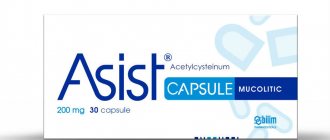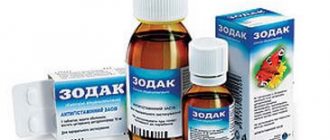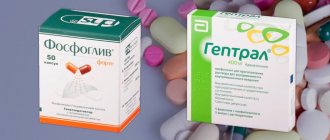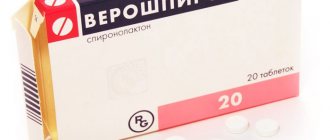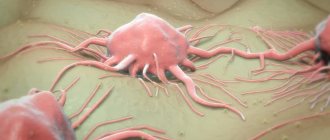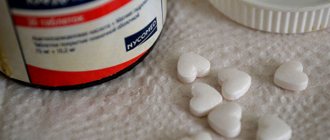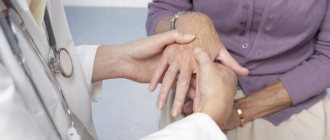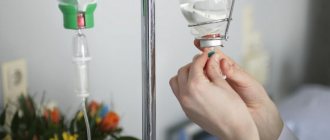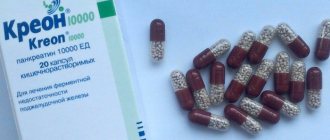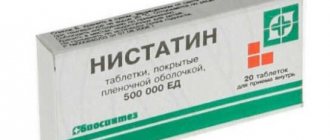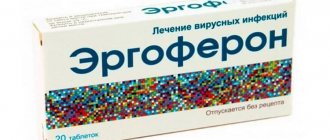Modern microgranular types with pancreatin (Creon, Micrasim, Ermital) are superior to the oldest medicine, but it still enjoys the trust of specialists and patients.
Official instructions from different companies create confusion in the minds of buyers, confusing the trade name of the drug “Pancreatin” with the main active component - a powder that is obtained from the pancreas of pigs and cattle (Pancreatin). When choosing the right remedy, you should pay attention to the possible inclusion of choleretic herbs, fiber, and intestinal enzymes in combination with it. Additional components are not useful for everyone.
For people of the Muslim faith, it is impossible to find a drug that has no connection with pork. The annotation does not indicate the exact origin of the raw materials. In terms of the composition of enzymes, the pig is closest to humans, therefore extracts of its organs are used to produce medicines.
Side effects
Any medication, regardless of whether it has a chemical composition or a natural one, can have side effects.
Pancreatin tablets are no exception. Reviews about them say that after taking them, narrowing may be observed at the junction of the large and small intestines and in the colon, which manifest themselves as constipation. With prolonged use of the drug in large doses, an allergy may occur, accompanied by skin rashes, swelling, spots and itching. In case of intolerance to certain components of the drug, the allergic reaction may be lightning fast. There may also be an increase in the amount of uric acid in the urine.
Drug overdose
Sometimes patients note in reviews that their stomach hurts after Pancreatin. This can happen due to individual intolerance, as well as in case of overdose. Long-term use of Pancreatin or consumption of it in large quantities can cause intestinal upset. After all, frequent intake of enzymes leads to a decrease in the secretory function of the pancreas. And a large number of them causes increased intestinal motility. This may explain why diarrhea occurs after taking Pancreatin.
In addition, prolonged supply of enzymes can lead to an increase in uric acid in the blood and urine. This can cause the formation of bladder stones. And in children, a large amount of enzymes can cause irritation of the mucous membrane of the mouth and anus. But cases of overdose are rare, since even 50 tablets are an acceptable dose - they contain the daily dose of lipase. But this amount can only be used as prescribed by a doctor.
Indications
- Cystic fibrosis or multicystic fibrosis of the pancreas;
- Enzymatic deficiency of the gland;
- Chronic pancreatitis of various etiologies in the stage of complete clinical and laboratory remission;
- Diseases of the hepatobiliary tract (chollangitis, cholelithiasis with a single fixed stone, chronic or subacute hepatitis);
- Functional dyspepsia;
- Surgical correction or chemo- and radioirradiation of the gastrointestinal tract in the late recovery period;
- If there is a violation of the mechanical processing of the food bolus (for example, a fracture of the jaw, bulbar disorders, mumps, a decrease in the number of teeth);
- Severe allergic diathesis;
- Dry food and other types of incorrect qualitative and quantitative composition of food products;
- To improve intestinal motility and speedy evacuation of chyme and feces before X-ray or sonographic examinations.
Pancreatin - instructions for use
The dosage of this drug is prescribed by the doctor in each case individually. Pancreatin's instructions contain detailed information on recommended doses and methods of use for various diseases. Before taking pills, laboratory tests are needed to indicate the level of enzymes in the duodenum. If the doctor has not given any special instructions, then taking tablets (capsules) can be done according to the following scheme:
- Adolescents 10-14 years old are prescribed medicine 2 tablets. simultaneously during meals;
- Children 6-9 years old are recommended 1 tablet/day;
- The dose for adults consists of 2-4 pcs. from 3 to 6 times/day.
For heartburn
What else does Pancreatin help with? According to the annotation, the drug can be used for heartburn. A burning sensation in the chest area, accompanied by belching, flatulence, nausea, sour or bitter taste, occurs for various reasons. These can be bad habits that cause weakening of the gastric sphincter tone or digestive disorders due to the composition of the food eaten, and much more. Pancreatin for heartburn not only helps to remove the symptoms of an unpleasant condition, but also restores the activity of the gastrointestinal tract. Duration of treatment: 3-4 days.
For gastritis
When the gastric mucosa becomes inflamed, its structure is disrupted, which leads to dysfunction of the organ. Pancreatin for gastritis will help to quickly overcome exacerbation of the disease, and if the pathology is in the chronic stage, then the medicine will stimulate and replenish missing gastric enzymes. By taking the drug, a person helps process food entering the stomach. The course of treatment depends on the stage of the disease, and lasts from several days to several months (at least two for complex pathologies).
For diarrhea
Diarrhea is always accompanied by loose stools three or more times a day. The main symptoms of diarrhea are loose stools and frequent bowel movements. Diarrhea can occur as a result of the development of many diseases, ranging from intestinal cancer, Addison's disease or diffuse pneumosclerosis, to infection with common Escherichia coli. Before taking enzyme tablets, you should understand the cause of diarrhea. If it is associated with exacerbations of gastrointestinal pathologies, then you can take the medicine according to the general scheme until the unpleasant symptom is eliminated.
Find out what other anti-diarrhea pills are available.
In case of poisoning
Intoxication of the body occurs for many reasons: ingestion of poor-quality food, after the administration of medications, after inhalation of toxic substances, after an insect bite and others. Characteristic manifestations of poisoning are nausea, vomiting, abdominal pain, diarrhea, and increased body temperature. Pancreatin is taken in case of poisoning if it occurs due to the intake of low-quality products. In other cases, other treatment is prescribed.
For pancreatitis
The action of enzyme preparations is not aimed at eliminating pain during exacerbations of the gastrointestinal tract, but at unloading the pancreas. When this organ becomes inflamed (pancreatitis), a person experiences symptoms of intoxication, severe abdominal pain and mushy stools. The pancreas cannot cope with digesting food. Pancreatin for pancreatitis helps prevent severe complications. However, there are forms of the disease in which you cannot take enzyme preparations, and there are those in which they are prescribed for life. In order not to aggravate the situation, self-medication is not allowed.
When overeating
Healthy people, after long holiday feasts, know why they drink Pancreatin. Enzyme preparations help cope with the digestion of fatty, heavy foods and avoid such unpleasant consequences as overload of internal organs, disruption of intestinal microflora, problems with blood pressure and erection, premature wear of joints, and the development of varicose veins. When overeating, pancreatin is taken immediately after a feast, 1-2 tablets at a time, washed down with water. It should be remembered that alcohol completely neutralizes the effect of the drug.
What does Pancreatin help with: indications for use
Pancreatin, as a substitute for its own enzymes, is indicated for patients with diseases and conditions caused by insufficient functional production of the pancreas. Exocrine disorders cause signs of digestive disorders and a predisposition to the inflammatory process. On the other hand, the presence of pathology in the liver, stomach, intestines, and gall bladder suppresses the synthesis of pancreatic juice.
Pancreatin is prescribed by doctors for therapeutic purposes for the following diseases:
- chronic pancreatitis,
- cystic changes in the gland in patients with cystic fibrosis,
- gastritis and peptic ulcer,
- cholecystitis,
- liver diseases,
- biliary dyskinesia,
- in the postoperative period, when part of the stomach and intestines is removed (Crohn's disease),
- in cases of compression of the ducts that carry contents into the duodenum, tumor, tissue edema after radiation therapy,
- development of autoimmune pancreatitis after organ transplantation,
- signs of enzyme deficiency in old age and in patients with type 2 diabetes mellitus, when fibrosis affects the glandular endocrine areas,
- forced immobility of patients (paralysis, paresis, fractures, obesity),
- consequences of cholecystectomy,
- failure to digest food caused by the inability to chew, dental problems, jaw fracture,
- unclear dyspeptic syndrome.
The body needs help if the breakdown is caused by overeating after fasting or on holidays, consuming a significant amount of fatty and fried foods that are difficult to digest, or a violation of the diet by diabetics.
Symptoms of disorder in the digestive system can be associated with the thoughtless use of fasting diets, significant breaks in nutrition, pregnancy, and stress. Children have to be treated for intestinal disorders caused by uncontrolled consumption of carbonated water, chips, fast food, when the baby is allowed to eat “adult” food.
Pancreatin can be used to cleanse the intestines of gases and normalize stools before ultrasound and x-ray examinations.
Clinical manifestations of enzyme deficiency are:
- dyspeptic syndrome (nausea, liquid stool with a greasy sheen, bloating),
- pain in the upper abdomen on the right, girdling in nature,
- heartburn and bitter belching,
- complaints from older people that “the chair either strengthens or weakens.”
You should not rely on a drug to combat obesity. The lipolytic enzyme transforms dietary fats into fatty acids, but does not remove endogenous and subcutaneous fat deposits. The drug helps restore metabolism. Perhaps if excess weight is associated with impaired absorption of fats, then the benefit will appear. However, using large doses without indications is strictly prohibited. A person will not stop getting fat, but will acquire additional dangerous problems caused by an overdose. You cannot treat yourself with Pancreatin.
In order to prevent exacerbation of chronic pancreatitis, patients during the period of remission receive a maintenance dose prescribed by the doctor. The theory of “pancreatic habituation” is not recognized by most gastroenterologists. Studies show the advisability of using enzyme preparations for compensation if the disease progresses and gradually affects a significant part of the organ.
Overdose of enzyme preparations
Data regarding intoxication of the body as a result of an overdose of enzyme preparations are not noted in the instructions for any of the described drugs in this group. However, taking large doses of the medicine can cause symptoms such as nausea, vomiting, perianal irritation, and diarrhea. In such cases, gastric lavage, hydration and further symptomatic therapy are performed.
But even in the absence of intoxication, you should experiment very carefully with the dosage and it is better to consult your doctor regarding the number of tablets and frequency of administration.
All of the above information cannot serve as a basis for unauthorized treatment.
It is very important to understand that enzyme preparations are medications that are designed to help the body, and self-medication can harm health and lead to even more serious illnesses
Consultation regarding the use of Pancreatin tablets and its analogues by young children is especially important, since an unformed child’s body is already subjected to serious tests during its formation period.
Pancreatin-LecT and Pancreatin: similarities and differences between drugs
The comparison table allows you to judge the difference in composition and suggest a more appropriate use.
Signs of Pancreatin Pancreatin-LekT Differences Release form Tablet coated with an acid-resistant coating Tablet coated with an acid-resistant coating Not detected Time of onset of action 30-45 minutes after administration 30-45 minutes after administration Not detected Composition of the tablet by weight of pancreatin 125 mg 90 mg Dose of active substance in Tyumen drug is 25% less Composition by activity in units according to the minimum limit Lipase 4300 Units, amylase 3500 Units, protease 200 Units.
- 3500 units,
- 3500 units,
- 200 Units
Pancreatin-LekT is inferior to regular pancreatin in lipolytic activity Cost 62 rubles. 36-47 rub. Pancreatin-LekT is slightly cheaper Use in children From 6 years old From 3 years old The LekT version is more necessary in pediatrics Differences in the composition of excipients (common components excluded) Available: sodium chloride, colloidal silicon dioxide, magnesium stearate, polyacrylate, starch. Available: polysorbate (Tween-80), ethyl acrylate, macrogol (polyethylene glycol 6000), lactose (lactopress), lactose monohydrate, calcium stearate. Technologists and biochemists could substantiate in more detail each substance; from a medical point of view, they can affect the body's hypersensitivity and cause allergies.
Taking into account the reduced dosage and earlier recommendations, use by age can be assumed: the Tyumen drug is more appropriate to use in pediatrics and for functional indications that do not require significant dosages.
Dosage of the drug
The leaflet for the drug "Pancreatin" contains information regarding taking the medication. However, this is only an approximate scheme; the exact dosage can only be prescribed by the attending physician after establishing the correct diagnosis.
Take the tablets with food, with a sufficient amount of liquid. Here are the recommended doses for treatment:
- for adults this is 2-4 tablets (16,000-32,000 units of the active component) at a time; up to 18 tablets, or 150,000 units, can be taken per day;
- babies up to 18 months can be given up to 50,000 units of the drug per day;
- children under 9 years of age are prescribed 1-2 tablets at a time, no more than 4 times a day;
- Teenagers need to take 2 tablets with meals.
In any case, before taking the drug, you should consult your doctor regarding its dosage and the need for therapy.
Due to the fact that each organism has its own characteristics, specialists often have to look for the optimal dose of the drug using the selection method. Initially, take the minimum dosage for a certain age category and, if the effect is insufficient, increase it until the maximum positive result is achieved after administration. In this case, they usually do not carry out any tests or examinations and rely only on the patient’s sensations.
Basic regimens and dosages
Pancreatin in any form is taken only when there is food in the stomach (during meals, immediately after). The drug should be swallowed whole; the tablet should not be chewed or crushed. To wash it down, half a glass of water or non-alkaline mineral water without gas is enough. Children are allowed to use tea and juice.
The dosage is selected by the doctor based on the clinical course of the disease, test results, and the patient’s age. The calculation is carried out in units, then the entire amount is divided into main meals (usually 3-4, but in case of chronic diseases it is possible more often, since fractional meals are indicated).
The daily amount of enzymes taken by an adult should not be higher than 15-20 thousand units. per kg body weight. For chronic pancreatitis, 2-4 tablets are prescribed per dose. If digestive breakdown is caused by overeating, then 1-2 tablets are enough. The sufficiency of the dose is determined by the elimination of signs of dyspepsia and pain. Correction is possible both in the direction of increase and gradual withdrawal of the drug after normalization of stool and well-being.
Regarding the prescription of Pancreatin to children, the official instructions indicate the possibility of safe use only after 6 years. Permitted dose:
- 6 years - 1 tablet per day,
- 8 years - 1-2 tablets or dragees,
- from 10 years - 2 tablets per day.
What is the need for a particular child is determined by the doctor, taking into account the recommendations of various manufacturers. For example, Pancreatin 8000 is generally not suitable for treating children; the instructions say that the drug has not been sufficiently tested in this age group.
The maximum dosages are used by patients with cystic fibrosis. For them, the daily requirement is 10 thousand units. (by lipase) per kg of body weight. It is more convenient to take drugs with high dosages of pancreatin (Creon 10000, 20000, 40000).
The duration of treatment for diet disorders and overeating is several days. To restore digestion during gastritis, peptic ulcers, cholecystitis, Pancreatin is prescribed for 1-3 months. In chronic pancreatitis, replacement therapy is carried out throughout life.
For gastrointestinal diseases
Reactive dysfunction of the pancreas accompanies inflammatory diseases of the stomach and intestines. The doctor judges the presence of organ failure based on tests and clinical symptoms and does not prescribe Pancreatin to all patients.
Excess enzymes can cause harm in the acute stage of the disease, because they stimulate hypersecretion of gastric and intestinal juice. Therefore, if necessary, the drug is used at the recovery stage, 1 tablet 3-4 times. This helps to expand the diet and switch to normal nutrition.
Pancreatin for diabetes
Diabetic patients need the drug if the disease is caused by primary pancreatitis or its connection to a violation of insulin synthesis by the endocrine part of the gland. The appointment is controlled by an endocrinologist. Forms of the drug without sugars are selected (dragées are not suitable). Low doses are sufficient - 1 tablet three times a day. Control tests include blood amylase and urine diastase.
For gallbladder diseases
Cholecystitis rarely occurs in isolation (without inflammation in neighboring organs). The gallbladder and the outflow tract into the duodenum are united with the pancreas by a common outlet and the work of the sphincter of Oddi at the exit border. Anatomical proximity made it possible to isolate the problem into the “common channel theory.”
When pancreatitis or cholecystitis spreads, it necessarily involves part of the excretory tract. A similar process accompanies the formation of salt concretions, which later turn into stones. Increasing secretion by adding enzyme activity causes the stones to move. This causes attacks of cholelithiasis (GSD), “hammers” and clogs small ducts. Stagnation promotes self-digestion of tissue.
Therefore, Pancreatin is contraindicated in the presence of stones, in the acute stage of the disease. To be sure of the choice, the patient must undergo an ultrasound examination. The drug is prescribed in the postoperative period following cholecystectomy. In this case, the absence of a bladder needs to stimulate the transport of bile through the ducts.
Pancreatin for the liver
Liver damage is caused by inflammation (viral and bacterial hepatitis), alcohol disease, fatty degeneration, tumors, and cystic changes. In patients with chronic diseases, liver function can be damaged by long-term use of drugs (anti-tuberculosis drugs, Paracetamol, Methyldopa, Nifedipine, Azathioprine, Amiodarone, tetracycline antibiotics, Clarithromycin, Ibuprofen, hormonal drugs, Indomethacin), contraceptives, poisoning.
If there is pathology of the organ, the need to use Pancreatin may be indicated by signs of involvement of the pancreas; the drug will not be able to cure the underlying disease.
Enzyme preparation is contraindicated:
- in the acute stage of hepatitis,
- with established liver failure,
- if the intrahepatic bile ducts are blocked or compressed by a cyst, tumor,
- when, based on biochemical blood tests, there is a suspicion of organ dysfunction.
Markers of damage to liver cells are considered to be the growth of enzymes: alanine and aspartic transaminases, lactate dehydrogenase, glutamyl transpeptidase, cholinesterase, arginase, bilirubin in the blood plasma.
What are Pancreatin tablets taken for?
This drug can be used alone or as part of a complex treatment. It is recommended to drink it when digestion is slow due to a sedentary lifestyle or impaired chewing function. Therefore, this drug is often used in old age. It is also effective for facilitating digestion after overeating or eating large amounts of fatty foods. Pancreatin is prescribed before a diagnostic examination of the gastrointestinal tract, for example, before an ultrasound. In these cases, it can be taken alone for a short time.
Course use of the drug is indicated for various diseases of the digestive system. In this case, Pancreatin is often prescribed together with other drugs. Indications for its use are the following pathologies:
- chronic pancreatitis;
- exocrine pancreatic insufficiency;
- chronic inflammatory pathologies of the liver and gallbladder - non-infectious hepatitis, fibrosis, cholecystitis;
- chronic gastritis, duodenitis, enterocolitis;
- cystic fibrosis;
- helminthic infestations and other parasitic diseases;
- conditions associated with surgery on the pancreas and small intestine;
- for chronic dyspepsia;
- after irradiation;
- with blockage of the biliary tract;
- with frequent occurrence of such symptoms of flatulence, diarrhea, nausea;
- after taking hormonal and antibacterial drugs.
For what diseases is Pancreatin used?
The medication is indicated for use for a more comfortable process of digesting food in various cases:
- inflammatory processes of the intestines, if the synthesis of enzymes produced by the glands of the organ mucosa is disrupted;
- chronic pancreatitis (with a lack of pancreatic enzymes);
- previous resection: surgical removal of some parts of the stomach;
- cystic fibrosis – insufficiency of the exocrine glands (considered a congenital pathology);
- eating too fatty foods (animal products);
- before conducting an examination of the (instrumental) digestive organs, such as preparation for ultrasound or radiography.
Many girls who are keen on diets take Pancreatin to quickly digest the food they eat. Doing this without prior consultation with your doctor is extremely dangerous. Despite the fact that the enzyme product is sold through pharmacies without a doctor's prescription, it is a medicine that helps cope with diseases of the digestive tract. Only a specialist prescribes an individual dose of pancreatin for each individual case.
General characteristics of the drug
The medicine "Pancreatin" is produced on the basis of the pancreas of cattle or pigs. Pancreatic enzymes are secreted from the gland, which are involved in digestion. They accelerate the absorption of nutrients in the small intestine. Many people know why they take Pancreatin tablets, so this medicine is quite popular. Moreover, its price is low - from 20 to 50 rubles per package.
The active ingredient of the drug is pancreatin, which contains the main pancreatic enzymes. These are lipase, amylase, trypsin and chymotrypsin. They help break down fats, proteins and starch into easily digestible substances. The drug is produced in tablets coated with an enteric coating, so the enzymes are not destroyed by the acidic contents of the stomach. Their concentration in 1 tablet is 25 units. They are released only in the small intestine, which increases the effectiveness of the drug.
Forms of release of the drug
Pancreatin is available in pharmacies in the form of tablets and dragees. Capsular preparations have a different name, although they also contain pancreatin. The surface of Pancreatin tablets is covered with a protective coating that prevents the contents of hydrochloric acid from being affected by gastric juice. Therefore, they are classified as gastroresistant. Pharmacologists can tell you the differences between dragees and tablets:
- the tablet is obtained by compressing the powder, looks flattened, then coated with an acid-resistant layer,
- dragees - have a spherical shape, the active ingredients are applied in layers, the additional components necessarily include sugar syrup.
Pancreatin in tablets is made by the Serbian company Galenika ad
The tablets are colored pinkish-brown, the dragees are bright crimson, and children's Pancreatin is green.
The mention of “pills” and the powder version of the drug should be left in the distant past. To this day, the network offers to buy pancreatin powder from the warehouse in bags by weight from 4.5 to 10 kg. The raw material has a grayish color, fine-grained structure, and a characteristic odor. But it is almost impossible to find a pharmacy that will do the hanging and make dosed sachets of 1.0 g. A special license is required for this.
It is completely impractical to engage in outdated production in the presence of a variety of cheap forms of Pancreatin.
Indications for treatment with the drug
The main purpose of pancreatic enzymes is to restore insufficiency of secretory function in diseases such as pancreatitis and inflammation of the pancreas. Also, such a hereditary disease as cystic fibrosis, which is expressed by blockage of the ducts and glands with a viscous secretion, is treated with the medicine “Pancreatitis”. Reviews from doctors about this drug indicate that these tablets help get rid of the symptoms of diseases such as chronic inflammatory-dystrophic lesions of the stomach, liver, gallbladder and intestines, even after surgery and radiation therapy of these organs.
The drug can be prescribed to patients with a diagnosis such as obstruction of the gallbladder and pancreatic ducts.
What else can Pancreatin tablets help with? They are also indicated for those who suffer from flatulence, diarrhea and nausea, and for people leading a sedentary lifestyle. They can also be taken by patients who are on a diet.
Features of taking medications for pancreatitis
The doctor must prescribe a treatment regimen and explain which medications for the pancreas should be taken after and which ones during meals. For example, enzyme medications for pancreatitis are taken simultaneously with meals, while antibiotics are taken after, proton pump inhibitors are taken once a day. Painkillers can be taken if necessary at any time, strictly following the dosage indicated in the instructions.
All tablets for pancreatitis should be taken with plenty of clean drinking water. During illness, alcohol is strictly prohibited, the toxins of which have a destructive effect on all cells of the body, including the pancreas. The combination of drugs with ethanol will increase the load on the liver, kidneys, and other organs of the digestive tract, leading to serious complications.
Any medicine can cause side effects and has contraindications, so before use you must read the instructions and tell your doctor about any chronic diseases. If a medicine for pancreatitis provokes complications and serious side effects, it should be discontinued immediately, replacing it with another active ingredient.
The duration of treatment with each specific drug is prescribed by the doctor. For example, antibiotics should not be taken for more than two weeks, as bacteria become addicted and the medications become ineffective. It is impossible to interrupt the prescribed therapy, since this can not only reduce the effectiveness of treatment, but also provoke a relapse of the disease.
For treatment to be effective, you must adhere to a diet. In the acute form of the disease, a hunger strike is indicated in the first two days, after which you can begin to eat low-calorie foods. Fatty, spicy, salty, peppered, smoked foods and other dishes that stimulate the secretion of gastric juice and gas formation in the intestines are prohibited. In the chronic form of the disease, their use should also be limited. Dishes should be steamed, stewed, boiled, or baked. Eat small meals 5-6 times a day.
Contraindications and side effects
The use of Pancreatin can have a detrimental effect on well-being and worsen the patient’s condition:
- for acute pancreatitis;
- with exacerbation of chronic pancreatitis;
- with intestinal obstruction;
- with individual sensitivity to the components of the drug;
- in children under 2 years of age.
To a greater extent, the drug is well tolerated by patients with digestive problems, but in some cases side effects may occur. They manifest themselves in temporary disruptions in the functioning of various organs.
| Organs in which violations occur | How does it manifest itself? |
| Digestive tract | Constipation, diarrhea, nausea, sometimes vomiting, epigastric discomfort |
| In the treatment of cystic fibrosis | May cause obstruction in the small intestine, stricture in the ileocecal region and ascending colon |
| Other failures | Decreased absorption of folic acid, allergic reactions of various forms, perianal irritation. |
Long-term use of the drug often causes hyperrucuria; large doses of the drug can cause hyperuricemia. An overdose makes itself felt with the same symptoms; in children under 14 years of age it can manifest itself in the form of constipation.
If symptoms are detected, you should immediately stop taking the drug and consult a doctor.
special instructions
The use of Pancreatin should be taken seriously, carefully study the instructions and indications. In treatment, the drug is never used alone; a diet, regimen, other medications, and physical procedures are prescribed.
It should be remembered that with a long course the drug exhibits harmful effects:
- absorption of iron in the intestine is delayed,
- Not enough folic acid salts are supplied.
This provokes the development of iron deficiency and B12 deficiency anemia. Therefore, the doctor must monitor hemoglobin and red blood cells in the blood.
Pancreatin should not be taken simultaneously with antacids (calcium carbonate, magnesium hydroxide). They reduce the effect of enzymes. If necessary, take a break of 1.5-2 hours between doses.
Among the forms for children there is a version produced in Ukraine. It is allowed to be prescribed from the age of three. Do not follow advice about crushing tablets into pieces or crushing them into powder. You should consult your pediatrician about the possibility of opening the outer capsule when replacing it with a drug in microgranules. Cases of oral irritation, stomatitis, ulcers, and perianal dermatitis have been reported in children. Allergies are more common in premature babies and those who have suffered a birth injury.
For constipation or diarrhea in pregnant women, the cause is hormonal changes and impaired peristalsis. It makes no sense to prescribe Pancreatin; enzymes do not affect intestinal motility. All manufacturing companies warn in the instructions about insufficient research on the effect of the drug on pregnant women and the fetus.
When purchasing, you should pay attention to whether the drug is expired by the date indicated on the package.
Possible side effects
Side effects from the drug were recorded in less than 1 case per 10,000 uses. Most often they manifest themselves in the form of an allergic reaction to the dyes that make up the tablet. If itchy rashes, swelling of the face, tongue, or nasal congestion appear, then stop using the drug immediately, take an antihistamine (Diphenhydramine, Suprastin, Loratadine), and tell your doctor.
In patients with cystic fibrosis, at high doses, there may be a disturbance in the metabolism of uric acid, an increase in concentration in the blood and urine, the appearance of joint pain, and attacks of urolithiasis.
The rarest complication is the formation of adhesions and strictures in the border zone of the ileocecal region, where the small intestine passes into the ascending colon. It manifests itself as signs of obstruction.
Overdose
Overdose occurs with constant consumption of high doses by patients with cystic fibrosis, or when patients self-medicate. In addition to side effects, exacerbation of diarrhea, pain in the epigastric area, nausea and vomiting are possible.
Contraindications to the use of Pancreatin
The drug is contraindicated for people with the following pathologies:
- acute pancreatitis, exacerbation of chronic,
- hypersensitivity to components, manifested by allergies,
- constipation caused by intestinal obstruction,
- acute form of hepatitis.
Antispasmodics for pancreatitis
Antispasmodics are used to eliminate pain during inflammatory processes. They have a relaxing effect on smooth muscles, which facilitates the removal of enzymes through the ducts from the pancreas. Antispasmodics are a temporary measure: as soon as their effect ends, the pain will return, so the main therapy should be aimed at normalizing the functioning of the organ. During an exacerbation, the doctor prescribes intramuscular or intravenous injections, less often - subcutaneous. For chronic inflammation, tablets are used.
To eliminate pain, No-Shpa (Hungary) or its analogue Drotaverine is often prescribed. The active substance of these drugs is drotaverine hydrochloride. The product relieves muscle spasms of the digestive tract, urinary system, biliary tract, gallbladder, and cerebral vessels. The effect of the medicine after oral administration occurs in a quarter of an hour, after the injection - in the second minute. For acute inflammation of the gland, the following is prescribed:
- for intramuscular injections: 2 ml of solution at a time;
- for an intravenous injection, 2 ml of the drug is diluted with 8-10 ml of physiological sodium chloride solution and administered slowly over five minutes;
- tablets: average daily dose – 80 mg, maximum daily dose – 240 mg.
Papaverine, the active substance of which is similar to the name of the drug, effectively eliminates pain. The medicine relaxes the smooth muscles of the digestive, genitourinary and respiratory systems, eliminates spasm of the valve, which is responsible for the outflow of juice from the pancreas. Various manufacturers produce the product in the form of tablets, suppositories, and injections. Medication dosage for adults:
- tablets: 40-60 mg 3-4 times a day, maximum daily dose – 0.6 g;
- subcutaneous and intramuscular injections for pancreatitis: 0.5-2 ml of a two percent solution, maximum single dose - 5 ml, daily dose - 15 ml.
Platiphylline reduces spasms of the abdominal muscles, reduces the tone of the smooth muscles of the bile ducts and gallbladder. Various manufacturers produce antispasmodics in the form of tablets or injections. To relieve acute pain, injections are prescribed: the solution is administered subcutaneously 1-2 ml two to three times a day, the maximum daily dose is 15 ml, a single dose is no more than 5 ml.
Atropine relaxes the smooth muscles of the digestive system and blocks sensitivity to acetylcholine, a neurotransmitter that carries out neuromuscular signal transmission. They are produced in the form of tablets and injections by different manufacturers. To relieve acute pain, 1 ml of 0.1% atropine sulfate solution is injected subcutaneously two to three times a day.
The drug has a stimulating effect on the nervous system and heart, so it should be used carefully under medical supervision
Reviews about the use of Pancreatin 8000
p, blockquote 19,0,0,0,0 —>
Due to my passion for fatty foods, I developed gastritis. During the period of its exacerbation, I have been taking Pancreatin 8000 for several years. Three to five days of treatment are usually enough to alleviate the condition; I have not observed any side effects.
Pancreatin 8000 is used after feasts and due to periodic overeating. I use 1-2 tablets three times a day for 2-3 days. Thanks to them, heaviness in the stomach, flatulence and bloating go away.
I have been taking Pancreatin 8000 for five years now, since an examination revealed problems with my pancreas. I take the drug at the maximum dose, and in all this time I have never seen any side effects, digestion has really improved and problems with the pancreas have decreased.
H2 blockers
When treating pancreatitis, secretion inhibitors - histamine H2 receptor blockers - must be prescribed simultaneously with antacids. These drugs make the receptors of stomach cells that produce hydrochloric acid insensitive to histamine. This reduces its synthesis and entry into the gastric lumen, which helps treat pancreatitis. The effect of blockers on the body is not limited to this: secretion inhibitors make the gastric mucosa more resistant to aggressive factors and promote its healing.
H2 blockers should be taken carefully, in the dosage strictly prescribed by the doctor, since they can cause many side effects. 1st generation medications cause the most complications
The following drugs are prescribed to treat an inflamed pancreas:
- Cimetidine. The drug is taken before or during meals. The maximum concentration in the blood is observed after 2 hours. This is a first-generation drug, so it can cause many side effects from different organs. Among them are diarrhea, flatulence, headaches, damage to the central nervous system, changes in blood composition, and decreased immunity. After a day, 48% of the active substance leaves the body.
- Ranitidine. The drug belongs to the second generation. Its activity is 60 times higher than that of Cimetidine. The medicine is taken regardless of food. The drug gives fewer complications and is characterized by a longer action. It is quickly absorbed into the bloodstream, the maximum concentration is observed after 2 hours. Forty percent of the active substance leaves the body after a day.
- Famotidine tablets. The drug is of the third generation, therefore much more effective than Ranitidine, has fewer side effects and is well tolerated. The product can be taken regardless of meals. The maximum level is observed after an hour, the half-life is 3.5 hours, the effectiveness lasts 12 hours.
Recent studies have shown that H2-histamine receptor blockers have many disadvantages. They are unable to maintain the required level of acidity for more than 18 hours; after treatment, many relapses occur, the body quickly gets used to the medicine and is able to resist it, and addiction occurs to taking the drugs. The biggest disadvantage of blockers is that their use can provoke the development of pancreatitis or its exacerbation.
Average price for Pancreatin-LekT and rules for dispensing from pharmacies
The drug is available in pharmacies for over-the-counter sale. Prices range from 36-47 rubles. per package of 60 tablets (bottle).
List of drug analogues with prices
Analogs of Pancreatin-LekT include preparations containing pancreatin in tablets, dragees, microspheres and capsules, combined products with dry bile and animal intestinal secretions, fiber. Prices are higher due to imported, improved form:
- Panzinorm in capsules - contains a higher dosage of enzymes (10,000 and 20,000) for lipolytic activity, packaging costs at least 100 rubles,
- Gastenorm Forte - available in film-coated tablets, containing 140 mg of pancreatin, price - 107 rubles,
- Mezim Forte is a popular drug in the form of coated tablets, the dosage can be selected according to lipolytic activity of 3500, 10000, 20000 units, for the minimum number in a blister you need to pay 80 rubles,
- Pangrol - available in capsules with lipase of 10,000, 25,000 units, film-coated tablets of 20,000 units, the price on the Russian market is on average 540 rubles,
- Creon is a capsule preparation that includes microspheres with the active substance, has a maximum dosage of 40,000 units, and the more common - 10,000, 20,000. The cost, depending on the form, varies from 228 to 600 rubles,
- Ermital is similar to Creon, the capsule drug can be purchased in dosages for 10,000, 25,000 and 36,000 units, respectively, the price of a blister with 20 capsules is 210-350 rubles,
- Micrazim is a Russian drug, dosage in capsules of 10,000 and 25,000 units. lipase, price - 230 rub.
The drugs have the same indications as Pancreatin-LecT and require careful comparison with tolerability and functional insufficiency of the gland.
Composition of the drug and name
The medicine contains special pancreatic enzymes, similar to those produced by the pancreas, such as lipase, amylase, protease, which promote digestion and better absorption of fats, proteins and carbohydrates in the small intestine. In fact, this is precisely what the entire digestion process consists of, and if an insufficient amount of enzymes is released, then the drug “Pancreatin” can compensate for them. Instructions for use, reviews, recommended doses will be described below.
What does the digital value mean in the name of the drug “Pancreatin 8000”? Reviews from patients say that this is the dosage most often prescribed by doctors. One tablet of the drug consists of 0.24 g of pancreatic enzymes, which, when converted into units, corresponds to 8000 units of the active component, hence the digital value in the name.
The composition also includes auxiliary components such as polyvinylpyrrolidone, magnesium stearate, macrogol, titanium dioxide, sodium chloride, aerosil, colicoate, talc, microcrystalline cellulose and carmosine.
pharmachologic effect
Digestive enzyme agent. The pancreatic enzymes included in the composition (lipase, alpha-amylase, trypsin, chymotrypsin) promote the breakdown of proteins into amino acids, fats into glycerol and fatty acids, starch into dextrins and monosaccharides, improves the functional state of the gastrointestinal tract, and normalizes digestive processes. Trypsin suppresses stimulated pancreatic secretion, producing an analgesic effect. The maximum enzymatic activity of the drug is observed 30-45 minutes after oral administration.
Other medications for pancreatitis
In some cases, with chronic inflammation of the pancreas, doctors prescribe sedatives that have a calming effect on the nervous system and reduce emotional stress. These drugs not only reduce depression, but also enhance the effect of pain medications for pancreatitis. Among these drugs are:
- Doxepin;
- Amitriptyline;
- Glycine;
- Phenibut.
If the pancreas is inflamed, the doctor may prescribe hormonal therapy. To suppress the production of pancreatic and gastric juice, Octreotide is used, an analogue of the hormone somatostatin, which is used to treat tumors. Corticosteroids (eg, Prednisolone) are prescribed if chronic inflammation is caused by an autoimmune disease. Hormonal therapy for a certain period of time, since long-term treatment can cause many side effects.
In chronic pancreatitis, indigestion accompanied by diarrhea is often observed. Enzyme deficiency slows down the digestion of food, which is why food is retained in the gastrointestinal tract, and bacteria settle in it, causing rotting processes, causing diarrhea and flatulence. Sorbents can cope with this problem. Smecta for pancreatitis neutralizes these processes, eliminating discomfort and stabilizing stool. The drug creates a protective membrane on the mucous membrane, envelops toxins and bacteria and removes them out along with feces.
Antibiotics are used to destroy pathogenic bacteria that provoke infectious complications: rupture of the pancreatic duct, bile stagnation, inflammation of the bile ducts, the appearance of cysts, bacterial infections. Drugs for acute pancreatitis are prescribed by injection, since in case of exacerbations it is necessary to act quickly. Antibiotics should be taken only as directed by a doctor, since they themselves can damage pancreatic cells and provoke inflammation. Among these drugs are:
- Ceftriaxone, Cefotaxime from the group of cephalosporins;
- Amoxiclav from the penicillin group;
- Thienam from the thienamycin group;
- Ampiox is a combination medicine of the antibiotics Ampicillin and Oxacillin;
- Vancomycin is from the group of tricyclic glycopeptides.
To prevent swelling of the pancreas and remove excess enzymes and poisons from the body, doctors prescribe diuretics - diuretics. For pancreatitis, Furosemide and Diacarb are prescribed in combination with potassium supplements. You should take diuretics strictly as directed by your doctor, since improper use can destroy pancreatic cells, provoke an increase in creatinine and urea in the blood, a severe decrease in blood pressure and other reactions.
Symptoms of pancreatitis
The pancreas synthesizes digestive enzymes and hormones that regulate protein, fat, and carbohydrate metabolism - insulin, glucagon, somatostatin. The organ has an oblong shape and is located in the upper abdomen, behind the stomach, in close contact with the duodenum. Iron weighs about 70 g, length ranges from 14 to 22 cm, width - from 3 to 9 cm, thickness - 2-3 cm.
Inflammation of the pancreas can occur in acute and chronic forms, the clinical manifestations of which are different. Acute pancreatitis is deadly, since toxins can provoke necrosis of pancreatic tissue and other organs, infection, and purulent processes. Even with timely treatment with modern means, the mortality rate is 15%.
There is no clearly defined clinical picture for acute pancreatitis, so additional examinations are necessary for an accurate diagnosis. In the acute form of the disease, false cysts often form in the pancreas, which cause pain in other organs and disrupt the movement of food through the stomach and intestines. In addition, the pathology manifests itself with the following symptoms:
- acute pain in the upper abdomen, radiating to the left side, back;
- nausea;
- vomiting with bile, which does not bring relief;
- bloating;
- dehydration;
- Jaundice may develop, accompanied by yellowing of the skin, dark urine, and light-colored feces;
- in some cases, bluish spots appear near the navel or on the left side of the abdomen, sometimes with a yellow tint.
With chronic inflammation, irreversible changes occur in the pancreas. It shrinks, the ducts narrow, the cells are replaced by connective tissue, which is why the organ ceases to perform its functions, and the synthesis of digestive enzymes and hormones decreases. Chronic pancreatitis is characterized by a vague clinical picture; its symptoms can easily be confused with other diseases of the digestive system.
The disease develops gradually and does not make itself felt for a long time. The pathology manifests itself as constant or periodic pain in the abdomen, near the left hypochondrium, and can radiate to the lower back. The disease is accompanied by nausea, vomiting, belching, heartburn, and an unpleasant sour taste in the mouth. Diarrhea may alternate with constipation; particles of undigested food are released along with feces. Sudden weight loss and the appearance of vascular spots are possible. Since the pancreas synthesizes insulin, chronic pancreatitis is often accompanied by diabetes mellitus.
Instructions for use
The leaflet in the box with the drug states that the product is intended to improve the digestive function of the body. Take it orally with plenty of liquid, ideally plain water.
It is correct to take Pancreatin during a meal or immediately after, and the required dosage is selected individually for each person. The required amount of the drug is determined by the deficiency of enzymes in the patient’s body.
Depending on the age and the established diagnosis for which the drug was prescribed, a single dose may contain from 1 to 4 tablets. The specified amount is consumed every time you eat. In special cases, the dose can be increased, but not more than doubled; this can only be done by a specialist.
The daily norm for an adult is 21 units, but if complete insufficiency of pancreatic secretory function is diagnosed, the dose can be increased to 57 units per day, which will completely cover the deficiency of enzymes in the digestive tract.
The daily requirement is calculated based on body weight. For an adult, it is 2-3 tablets per kilogram of weight.
Cystic fibrosis in children under four years of age will require taking it according to the instructions, one tablet for every 14 kg of weight is enough. Older children are recommended to take one tablet per 7 kg of weight.
In rare cases, the drug can be prescribed to children over one and a half years old. The daily norm for them is 50,000 units of the active substance; just one tablet will be enough.
The course of treatment is purely individual; it is selected depending on the disease and the severity of its course. For some, only two days will be enough to get rid of problems with the pancreas; for some, this lasts for months; there are cases of therapy lasting several years.
additional information
There is no experience with the use of this particular drug (“Pancreatin 8000”) for the treatment of young children. In this regard, it is not recommended for use in patients under one and a half years of age.
Intestinal obstruction is a common complication in patients with cystic fibrosis. Thus, if you have symptoms that indicate the presence of such a condition, you should be aware of the possibility of intestinal strictures.
"Pancreatin 8000" contains active enzymes that can damage the oral mucosa. Therefore, the tablets must be swallowed whole without chewing.
